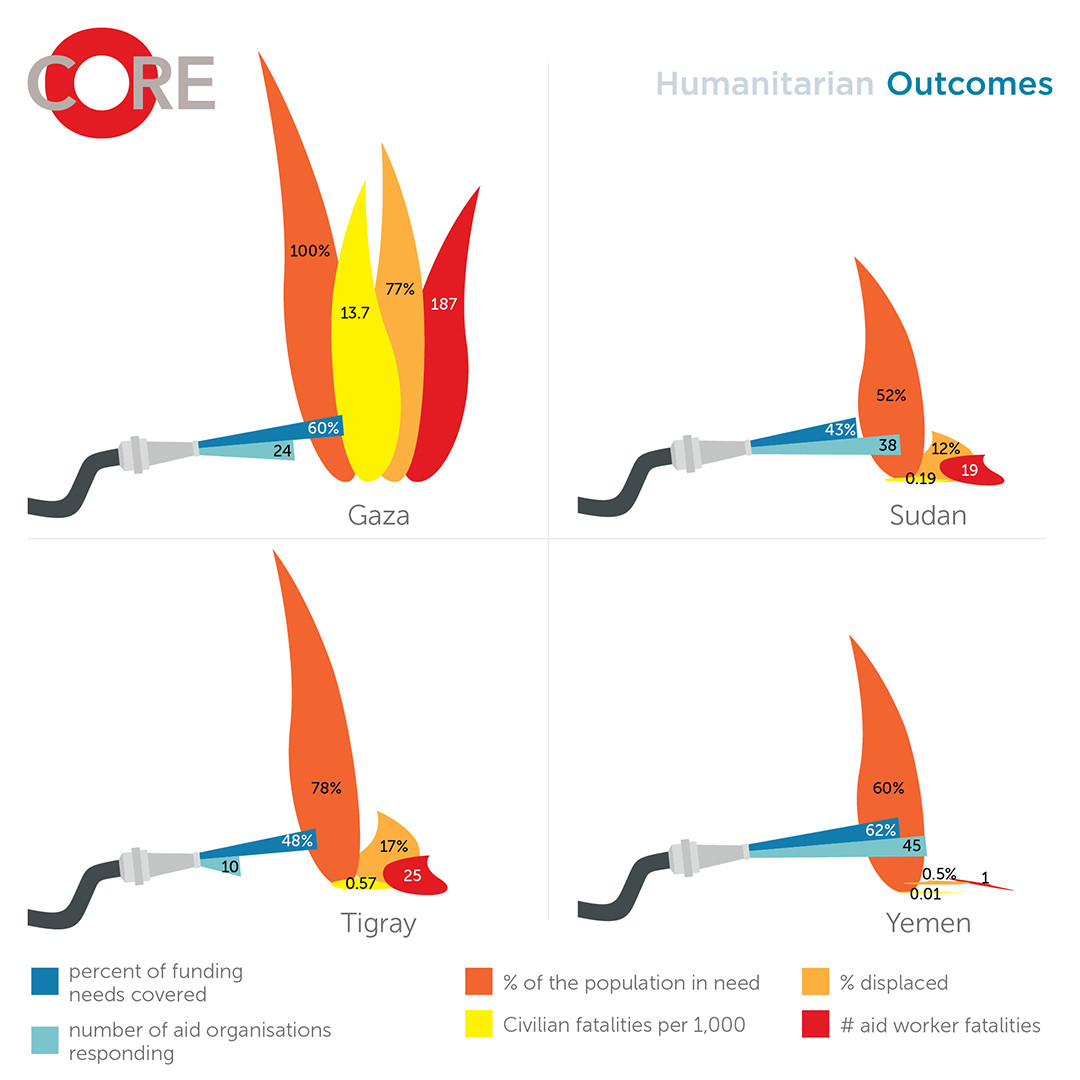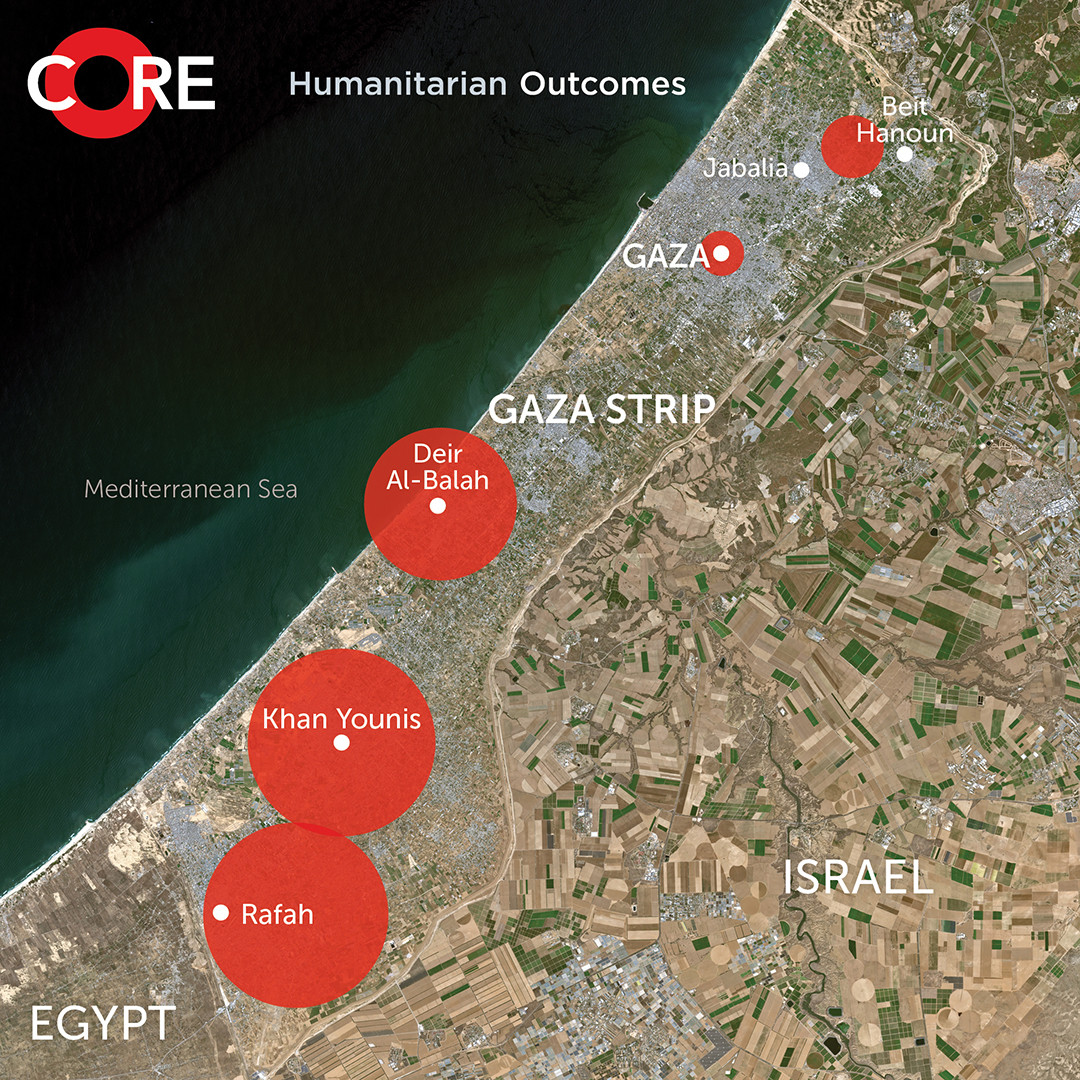Gaza
| CORE Programme I Sudan | Haiti | Myanmar | Iraq | Ethiopia: Tigray | Afghanistan | Northeast Nigeria | Central African Republic | Global Report

Summary
Beyond the cost in human lives and suffering, and the instability it brings to the wider region, the war in Gaza has had serious repercussions for international humanitarian law (IHL) and norms around humanitarian access.
Since the beginning of the current conflict, precipitated by the attack on Israel by Hamas on 7 October 2023 and followed by a major military offensive by Israel, humanitarian aid for civilians entering Gaza has been far less than what is needed, with hardly any of it reaching the north. Tight restrictions on aid goods, equipment, and personnel allowed to cross into Gaza have severely limited operational capacity for distribution, and there is no protected operational space for humanitarian efforts. Over 30,000 civilian deaths have included over 150 aid workers, an unprecedented number for a single context in such a short period. The mounting scarcity, desperation, and the breakdown of civil order have meant that the small amount of aid coming into Gaza on trucks is often seized before it can be distributed in a safe and principled way. People are now struggling to meet basic survival needs, with the first deaths of children from acute dehydration and malnutrition reported in early March 2024.
- The telephone survey of Gaza residents conducted for this report in mid-February found the following.
- Less than 30% of respondents in the north had received any aid at all since the crisis began.
- The aid being delivered is mainly in the form of food and is insufficient. Most aid recipients said the aid they received did not meet their priority needs and only 3% of people who received help said it was in the form of medical aid or clean water.
- The UN agency, UNRWA, remains the lynchpin of aid delivery in Gaza, cited by respondents as by far the most present and effective aid provider. The recent defunding of UNRWA by its largest donor, the US, threatens to remove the main mechanism for distribution of critical goods and services.
- Other aid providers that were (less often but repeatedly) named were the Ministry of Social Development, the Palestinian Red Crescent Society, World Food Programme (WFP), UNICEF, International Red Cross and Red Crescent Movement members, the Palestinian NGO MA’AN, and a very small number of international NGOs. In all, fewer than 10 international NGOs have managed direct operations in Gaza since the war began.
- People blame authorities on both sides of the conflict for hindering humanitarian aid. While the Israeli border restrictions were named as the biggest obstacle to aid coming in, in terms of their own ability to access the aid inside Gaza, the second largest obstacle according to respondents (after distance) was “local officials took or blocked the aid”. A plurality of commenters reported corruption, diversion, and favouritism in distributions, with many remarking on seeing aid for sale in local markets.
The Gaza crisis presents enormous challenges to humanitarian access in all conceivable respects: major collateral violence from ongoing hostilities, generalised crime and disorder, heavy logistical constraints, extreme political sensitivities, and bureaucratic blockages. Advocacy and diplomatic efforts to secure ceasefires, facilitate humanitarian operations, and allow for more aid into Gaza have been intensive and ongoing, but so far yielded very little result. As yet unable to exert pressure sufficient to improve humanitarian access, the US government has attempted workarounds such as airdrops – an extremely risky and suboptimal measure considered a last-resort option for aid – and is currently planning for an offshore delivery platform.
Alongside the ‘Western’, UN-led humanitarian response has been a substantial response from states, civil society, and the private sector in the Arab world. Gazans themselves are doing what they can to help each other with community-based efforts and networks of support, but displacements and increasingly diminishing resources have debilitated these efforts. Trauma, fear, bereavement, and fatigue have naturally also exacted a heavy toll on aid workers in Gaza.
More than other armed conflicts in recent memory, humanitarians fear the implications of the Gaza crisis on future adherence to IHL and the ability of aid organisations to negotiate access based on these principles and norms. More immediately, however, they warn that without massive upscaling of aid operations allowed to take place, the humanitarian and health workers in Gaza that have struggled to meet the needs of the civilian population will be unable to continue, leading to an even greater calamity.

